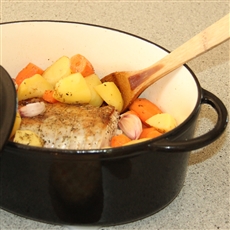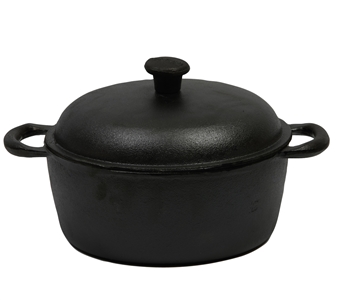How to correctly prepare for braising, the type of casserole dish, the meat, the temperatures, the wine or stock...
Everything to braise in a traditional or modern way by putting the casserole dish in the oven.
"Good preparation is essential for braising - the type of casserole dish, the meat, the temperature, the wine or stock...
Everything you need to successfully make traditional or modern braises using an oven casserole dish.
Today´s modern ovens are very well insulated, meaning that you can maintain a constant temperature while consuming minimal energy. With the help of a good casserole dish, traditional braising that has made French cuisine´s reputation is accessible to everyone.
Roasting or braising in a casserole dish is not a new technique. Before gas cookers became common, cooks used cast iron or copper braising dishes with hollow lids to keep the cinders and ash hot. Heated both above and below, the food was first seared and then boiled in a covered pot for a long time.
Using a casserole dish in the oven offers many advantages.
:
- your oven will not get dirty,
- you use fewer volatile flavours,
- your meat feeds on its juices in the same way as a marinade, preventing the surface from drying out,
- and you get the natural effect of steam cooking that increases the flavours.
In the oven, a cast iron casserole dish behaves in the same way as a braising dish. It is heated above and below, it distributes the heat and water loss is reduced.
Why sear to begin?
The main advantage of cooking in a casserole dish is cooking in a closed environment that encourages an exchange of pleasant flavours. Hints of grilling add succulence that is hard to do without.
There are two options available:
1. Browning. At the start of the cooking process, in the hot casserole dish, you can easily manage the grilling strength. If you are working with a pure cast iron casserole, the grilling will take place more quickly. This is an advantage. After browning, deglaze and prepare the casserole for the oven.
2. Traditional grilling. The other method is more specifically adapted to traditional braising which made the reputation of our great gastronomical cuisine. Cover the bottom of the casseroles dish with lard and put into a hot oven. It will remove the fat and prevent sticking?. When the grilling point is reached, take out the meat, add onions, carrots and herbs to add flavour, put the meat back in and wet it without covering it.
We should note, by the way, that meat that is recommended for ""braising"" offers the best results with this kind of cooking method, but any kind of meat will do.
Cooking
: don´t let it burn!
In the past, when food was still cooked in the fire, cooks always feared a sudden flame. Braising is a form of slow cooking that softens meat, but if it gets too hot, the opposite effect will occur. Technically, instead of the collagen dissolving into the water of the cells (collagen is what makes meat tough), the cells are punctured and the water will be lost. Without water, the collagen will no longer dissolve, the meat will remain tough and dry out, even if it is cooked in a lot of liquid. On the other hand, once dissolved in the water of the cells, the collagen forms a kind of jelly that transports all kinds of flavour.
To avoid this unfortunate overheating, nowadays we have a very reliable instrument
: a thermostat oven. There can be no mistake - simply select the temperature, and as the braised meat is cooked in a closed environment, the meat will not become dry.
Once your braise has been coloured, wet it with aromatic stock wine. The temperature will drop significantly, and like a marinade, the meat will feed on the additional aromas without losing its own flavours. Cover the dish with a lid and return to the oven.
What temperature?
Ideally, you should consider braising like low temperature cooking, or more precisely, exact temperature cooking. Under the heat´s action, the proteins coagulate. This is what happens when you cook an egg. At 62°C. the white begins to coagulate to become hard at around 70°C. The yolk mainly consists of another protein (ovovitelline) and it begins to lose its fluidity at around
70C°, becoming completely hard at 85°C.
Like an egg, the proteins in the meat coagulate and harden. If we want to avoid this hardening and water loss, it is preferable to work at a temperature that is below that of coagulation. In any case, stay below 100C° or boiling point. If the water in the cells is boiled, the steam will cause the cell membrane to pop, the coagulated proteins with retract and the water will come out. This is what you want to avoid above all else.
Like any low temperature cooking, choosing the temperature is a question of taste. The example of beef is a good demonstration of this.
- Blue
: 55°C. at the heart.
- Rare
: 63°C.
- Medium rare
: 70°C.
- Well done
: 77°C...
There is less than 15° between a well-cooked and a blue piece of beef!
When braising, you can work with temperatures that are commonly used in gastronomic restaurants
or for sous-vide cooking:
- Poultry: 66/72°C
- Pork: 65/70°C
- Beef: 66°C
- Veal: 66/70°C
This is a good basis and you can also keep track of the temperature using a thermometer.
6 / 7 hours of cooking
Cooking time depends mainly on the size of your casseroles dish and the size of the piece of meat you are braising. With an oven at 80°C, count 6/7 hours of cooking for a 2 or 3 litre casserole dish. But it can be much longer. To gain some time, you can cook your dish in the oven for 30 to 45 minutes at 180°C before turning down the temperature of the oven to the degree you want it to reach at the heart of the meat. Be patient.
What type of casserole dish?
The technique of braising is best suited to big pieces and the size of the casserole dish is primordial. The space between the meat and the edge of the dish should be kept to a minimum in order to concentrate the flavours. You can use a pure cast iron oven dish. This is suitable for browning the meat.
Stock, wine and aromas
After browning, when your dish is prepared and ready to go into the oven, it is time to moisten your meat with wine or stock without covering it. Braising is not boiling. Diluting the flavours is not the point. On the contrary, the goal is to concentrate them. That is why the casserole dish should be quite full.
Moisten with hot stock."
























